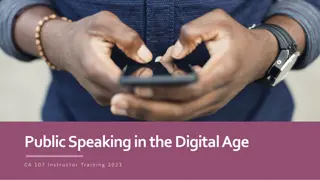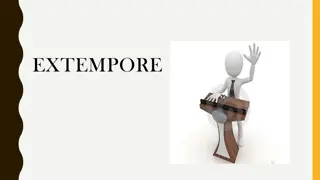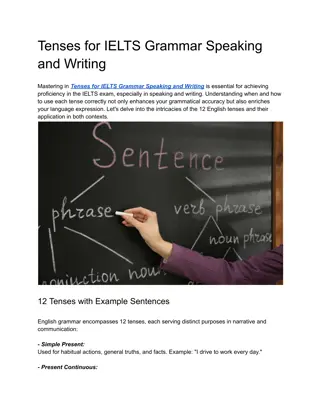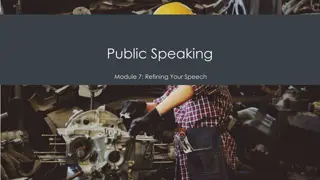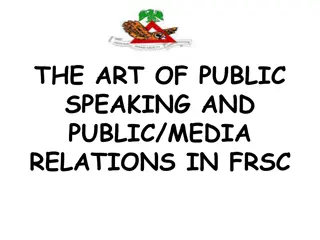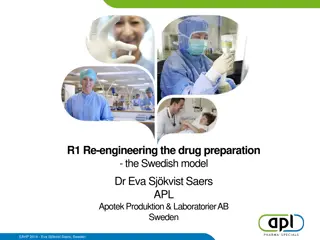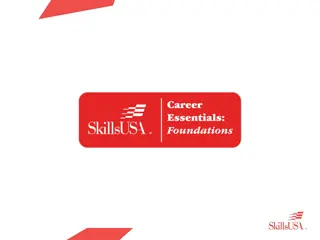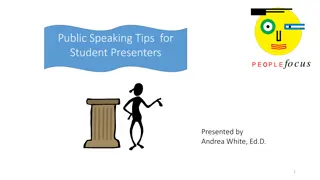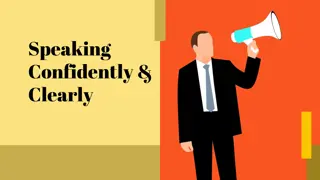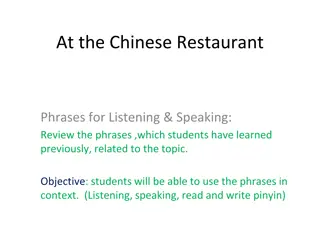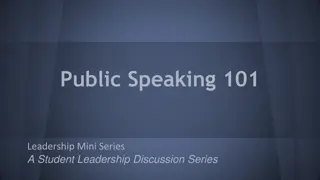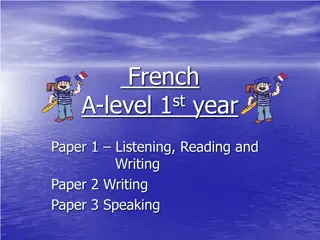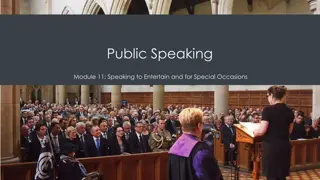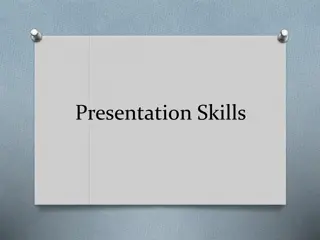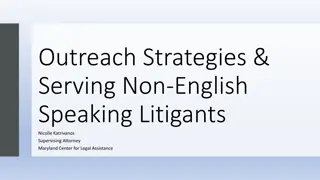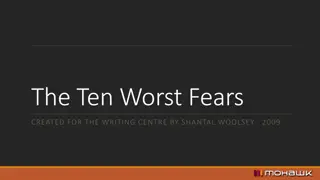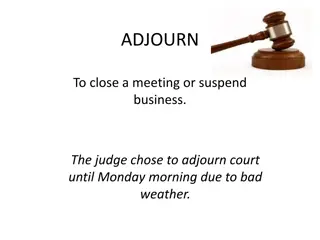Mastering Extemporaneous Speaking Techniques
Enhance your extemporaneous speaking skills with tips on answering questions, types of questions, and crafting effective responses. Learn about umbrella answers, unified analysis, and the importance of providing independent points to support your arguments.
Download Presentation

Please find below an Image/Link to download the presentation.
The content on the website is provided AS IS for your information and personal use only. It may not be sold, licensed, or shared on other websites without obtaining consent from the author.If you encounter any issues during the download, it is possible that the publisher has removed the file from their server.
You are allowed to download the files provided on this website for personal or commercial use, subject to the condition that they are used lawfully. All files are the property of their respective owners.
The content on the website is provided AS IS for your information and personal use only. It may not be sold, licensed, or shared on other websites without obtaining consent from the author.
E N D
Presentation Transcript
Advanced Extemporaneous Speaking Rhonda Smith
The First Rule of Extemp is Answer the Question!
VERBATIM Answering the Question Answering some other question Room to include an umbrella answer, framework/lens through which to analyze the topic, etc. (parametrize) Inclusion of unnecessary qualifiers: only/and/or/but/not Exclusion of necessary qualifiers: only/and/or/but/not Will there be a bipartisan agreement on infrastructure? Will there be an agreement on infrastructure?
Types of Questions 1. 2. Descriptive Prescriptive
1. Descriptive The answer describes an outcome. Predictive Questions/yes or no Who/what/when/where/why Because
2. Prescriptive The answer prescribes a solution. Solvency Steps How
Umbrella Answer This should answer the question and also create a general framework for the points to fall under, usually narrowing the topic.
Unified Analysis Each point independently answers the question in the way that you have specified you are going to answer the question.
Independently Question: What steps does x person need to take to win x election? Answer: x person needs to become more relevant, and can do so with these 3 steps: 1. Create grassroot support 2. Use grassroot support to expand voter registration 3. Have more televised appearances
Independently No point should depend on another point to be true or to happen first (preempt) Answer: x person needs to become more relevant, and can do so with these 3 steps: 1. Create grassroot support 2. Use grassroot support to expand voter registration 3. Have more televised appearances
Independently Question: What steps does Joe Biden need to take to cement a second term in the White House? Answer: He needs to address the issues deeply affecting the American people, and he can do so by taking 3 steps: 1. Initiate economic reform 2. Expand educational opportunities 3. Subsidize agricultural subsidies
Independently No point should encompass or be an example of another. Answer: He needs to address the issues deeply affecting the American people, and he can do so by taking 3 steps: 1. Initiate economic reform 2. Expand educational opportunities 3. Subsidize agricultural subsidies
in the way that you have specified Question: Will Republicans take back the House in 2022? Answer: Yes, for 3 reasons: 1. Republicans are well organized 2. Republicans are growing momentum 3. Republicans don t have enough money
in the way that you have specified Question: Who is most likely to be the Republican candidate in 2024? Answer: Donald Trump because he has the broadest appeal 1. He is the strongest fundraiser 2. He appeals to Republican base 3. He is experienced 3. Democrats don t have enough money
Comparison Questions Before v. After Actor v. Actor Actor v. Field Policy v. Policy Has the Affordable Care Act improved healthcare in the US? Who has more momentum going into 2024: Joe Biden or Donald Trump? Who would be the best replacement for Donald Trump? Should the US increase it s funding of NAFTA or withdraw completely?
Solution Questions How do you fix American healthcare? a. Inherency (Problem) b. Proposed solution m. Alternative world What does Trump need to do to fix his relationship with the media? What steps can we take to address police brutality? How can the World Health Organization boost its credibility in the midst of the COVID19 pandemic?
Background Time: 25 - 30 seconds What does the judge need to know to follow the speech? think framework/context What s going on? The judge is NOT an expert on the topic. The judge did NOT just research the topic for 30 minutes. This is a good place to cite a source 1:58
Transitions: Example 1 Intro: If the triumphs of great Italy could be summarized, it would be giving the world the Mario Brothers, spicy meatballs, and pizzas bigger than you can imagine. However, what they ve also given us, is one of the most corrupt banking systems in the modern European Union. Point One: It s no surprise Italy s banking system has gone down the toilet, and it s going to take a lot of work to get it out. Point Two: If the system s weak leadership wasn t tantalizing enough, here s where things start to get spicy. Point Three: Everyone loves pizza; the more the merrier. But besides (Point 1 and 2), Italy seems to be piling on the toppings of their financial fallout out with (Point 3).
Internal Transitions Moving from thought-to-thought within a singular point Can be used to bring up a new source, idea, opposing opinion, etc. Examples include moreover, additionally, furthermore, however, despite this, in contrast, and many more VARY YOUR WORD CHOICE Try making a list of all the transitional words you can think of and attempt to use several of them to avoid repetitiveness
Good extemp requires thinking. It provides a forum to share one's thoughts. Judges will remember arguments that come from autonomous thinking because they are fresh. Eventually, students should be able to use sources to get information, then draw a conclusion about their impact.
Research is necessary to frame and carry Research is necessary to frame and carry forward an argument forward an argument logos comes from here. logos comes from here. Whose perspective am I considering and why? What mindset am I taking when determining whether an argument is valid? Argumentation is a process and must consider context. It isn t about being correct because there are multiple answers. It s about persuading someone else that your answer is correct.
Deeper Analysis Explain it like I m 5 A warrant must be logical to be meaningful. Narrowing the scope of the answer through the umbrella answer allows the explanation to follow a full logical progression. Use examples to demonstrate ideas when necessary to clarify the point. Make the answer and analysis clear to the judge.
Logic covers all parts of the argument. Topicality Significance Harms Inherency Solvency
Generally, speeches need 7-9 sources 1 in the intro 2 in each point (1 in each subpoint) If possible, adding one source to each impact would also bolster credibility! Use recent sources! Sources more than six months old are rarely relevant. Use region-specific sources Ex: in a speech about China, a source like the China Daily News or for an education topic, cite American Educator.
Sources can be used to draw a conclusion or state a fact but be sure they are useful. A source isn t necessary that says the presidential election is in November or that COVID-19 has led to many deaths. Sources that contain statistics are often helpful in supporting arguments but beware of skewed numbers. (methodology) A source is not a warrant, but it can contain a warrant. Someone saying something is true doesn t make it true. Opinion/Bias A warrant is why the claim is true.
Sources Matter Time frame Credibility Honesty Variety
Types of Sources Daily News Weekly/Quarterly Specific Think Tanks Journals/Periodicals Topic Specific/Country Books with deeper analysis Broader use Avoid newswires and blogs Use a variety for best results =)
Credibility Read and use transcripts when possible. Read from multiple sources. Real Clear Politics offers multiple articles from a variety of sources for a good starting point. Know the bias of sources. Try to avoid opinion and highly biased sources. Check the chart some of what you think is highly biased isn t, and some of what you think is mostly unbiased isn t. https://mediabiasfactcheck.com/ https://thebestschools.org/features/most-influential-think- tanks/
Read Every Day Websites Daily email Apps Press Conferences and CSPAN give you first-hand information and prevent cherry-picked news from giving a false narrative. Listen to podcasts familiarize yourself with multiple perspectives so you get a more well-rounded picture since the truth usually falls somewhere in between the two narratives. Sign up for notifications Read books*** Most books are useful in multiple topic areas.
Citing sources Publication (what is the source) Author if well known can add credibility Include month, day and year when possible at least month and year.
Internet usage While it can help you find specific information, if you don t know anything about your topic, going to the web is unlikely to give you what you need in a short amount of time. Rather using the Internet should be a last resort to get a definition or specific information. It s hard to narrow your search to relevant, credible sources from multiple types of publications.


